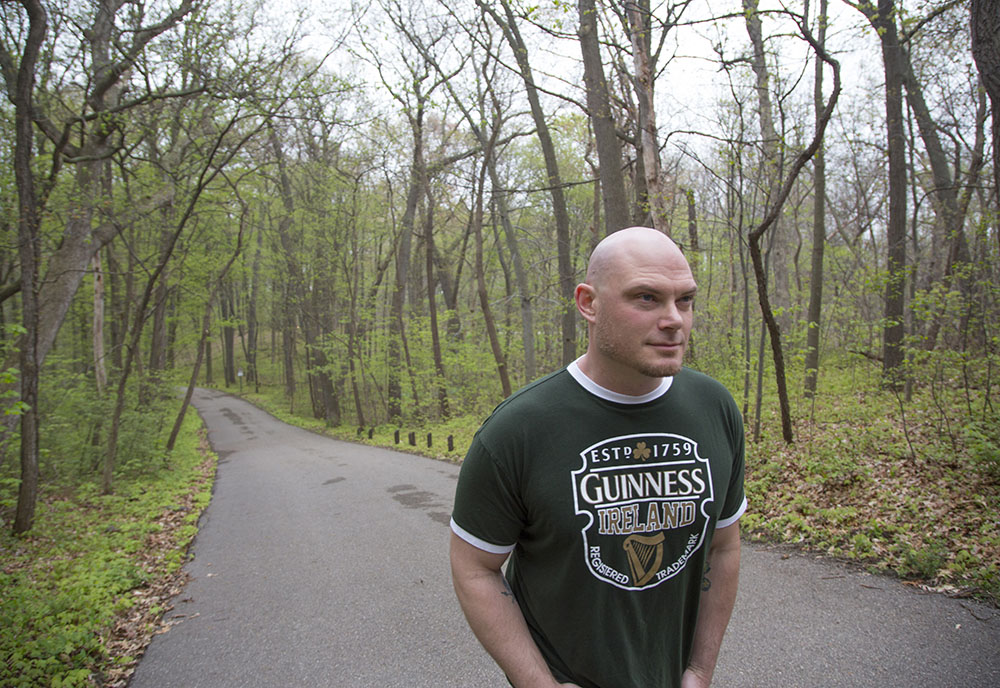Veterans Health Administration
PTSD Help with Cognitive Processing Therapy

Taking the Blinders Off: Veteran Christopher Tyler’s experience with CPT
In observance of PTSD Awareness Month, June 2016, VA’s National Center for PTSD presents the following profile of a Veteran who is living with PTSD and has turned his life around with treatment.
Chris Tyler joined the Army in 1996, right after he graduated from high school. During his nine years of service he was deployed to Kosovo for six months and to Iraq for 17 months.
In Iraq he was part of the 168th Military Police Battalion. He did guard-tower duty. He transported fuel and ammunition. He worked the front gate of his base. But the most dangerous part of his job was prisoner transport.
“My main job was to pick up prisoners from Baghdad police stations and take them to be interrogated by Special Forces at the Baghdad airport,” Tyler said.
To get to the airport, Tyler drove “Route Irish” known at the time as the most dangerous road in the world.
“It was a little nerve-racking to work that road…constant watching of all directions,” he recalled. “Debris on the road could be a roadside bomb. There was a lot of heavy traffic…and then, holding prisoners…in the back of your truck, you don’t really stop for anybody.”
Tyler’s vehicle frequently came under attack. One incident in particular would haunt him for years to come.
When he got back home to Michigan, Tyler knew he had changed. He had a hard time making sense of civilian life. His marriage became strained. His friendships suffered. Work was difficult. He was depressed and angry. He thought about suicide.
“I was just a shell. I was kind of drifting through life,” Tyler said.
Identifying Negative Thoughts Called “Stuck Points”
Finally, eight years after leaving the military, Tyler sought help from the VA. He was diagnosed with PTSD and decided to enter a residential treatment program where he began Cognitive Processing Therapy (CPT). In CPT, patients are taught how the way they think can negatively affect the way they live, and how to recognize the thoughts that are making life difficult. Tyler would spend the course of his therapy learning how to reframe those thoughts. Though it sounds simple enough, to Tyler, it was fraught with risk.Tyler carefully read through his Impact Statement, both on his own and with his therapist. The goal was to identify negative thoughts called “stuck points.”
“The stuff actually works. It’s very real.”A stuck point is a thought or belief that people with PTSD just can’t get past and keeps them from living the way they want. It could be a thought like, “I shouldn’t have survived that attack.” Or “danger lurks around every corner,” Or “no one can be trusted.”
With the help of his therapist, Tyler would learn to recognize his own stuck points, and then learn the tools to understand and eventually defuse them.
Over the course of his therapy, Tyler used a variety of written worksheets to understand how his thoughts were causing him distress. Not only did they cloud over his days, but they cast a dark shadow over his past as well. Much like his cache of military treasures, Tyler had kept his most difficult memories tucked away.
Unpacking the Memory of a Traumatic Event
Under the guidance of his therapist, he would unpack and inspect the one thing he’d kept locked up tight: the memory of the traumatic event.
For Tyler, this moment would be pivotal.
The tools Tyler learned in CPT gave him a new perspective on how ingrained and rigid his thoughts had become. He became more flexible in his thinking. From this new vantage point, Tyler could see his traumatic event in a more realistic light. The dark clouds started to lift, and relief, at one time unimaginable, was in sight.
His life began to change for the better.
When Tyler began treatment, he worried that therapy would push him over the edge—that he’d come out worse than when he went in. Instead, Cognitive Processing Therapy helped him break the cycle of his negative thinking, and reframe his perspective on the past…and the present.
He became less suspicious of the world. He was able to engage with people, to make and keep friends. And he was able to see his military experience, even the darkest moments, in a new, more insightful way. It wasn’t easy, but Tyler came through CPT with his PTSD under control and ready to re-engage.
“I thought it’d be all smoke and mirrors and, you know, a dog and pony show like they call it in the military,” he said. “But, no, it’s definitely not a dog and pony show. The stuff actually works; it’s very real.”
You can see the entire AboutFace video “Therapy Story” about Christopher Tyler at http://www.ptsd.va.gov/apps/AboutFace/therapies/cpt.html
For more information on PTSD and ways to raise awareness throughout the year, visit the National Center for PTSD website, www.ptsd.va.gov/about/PTSD-awareness/. This site offers resources such as:
• PTSD Coach Online and the award-winning PTSD Coach mobile app, which provide symptom-management strategies. The app is always with you when you need it.
• Continuing Education (CE) and continuing medical education (CME) opportunities for providers on the best practices in PTSD treatment (CEs/CMEs offered), including the PTSD 101 curriculum.
• AboutFace: An online video collection of Veterans talking about PTSD and how treatment turned their lives around.
• Whiteboards: Short animated videos to learn about PTSD and effective treatments.
• Subscribe to the PTSD Monthly Update: Stay up to date on new information about PTSD and trauma year round.



















